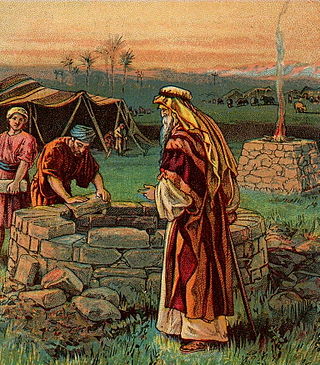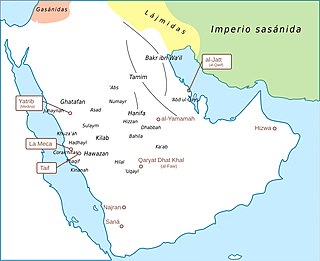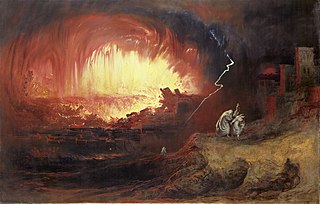
Abraham is the common Hebrew patriarch of the Abrahamic religions, including Judaism, Christianity, and Islam. In Judaism, he is the founding father of the special relationship between the Jews and God; in Christianity, he is the spiritual progenitor of all believers, whether Jewish or non-Jewish; and in Islam, he is a link in the chain of Islamic prophets that begins with Adam and culminates in Muhammad.
The Book of Genesis is the first book of the Hebrew Bible and the Christian Old Testament. Its Hebrew name is the same as its first word, Bereshit. Genesis is an account of the creation of the world, the early history of humanity, and the origins of the Jewish people.

Isaac is one of the three patriarchs of the Israelites and an important figure in the Abrahamic religions, including Judaism, Christianity, and Islam. Isaac first appears in the Book of Genesis, later adopted by the Hebrew tradition of the Torah, in which he is considered to be the son of Abraham and Sarah, the father of Jacob and Esau, and the grandfather of the twelve tribes of Israel.

Sarah is a biblical matriarch, prophet, and major figure in Abrahamic religions. While different Abrahamic faiths portray her differently, Judaism, Christianity, and Islam all depict her character similarly, as that of a pious woman, renowned for her hospitality and beauty, the wife and half-sister of Abraham, and the mother of Isaac. Sarah has her feast day on 1 September in the Catholic Church, 19 August in the Coptic Orthodox Church, 20 January in the LCMS, and 12 and 20 December in the Eastern Orthodox Church.

Ishmael was the first son of Abraham, the common patriarch of the Abrahamic religions, through his wife Sara's handmaiden Hagar. According to the Genesis account, he died at the age of 137. According to biblical tradition, he is the ancestor of the Arabs.

According to the Book of Genesis, Hagar was an Egyptian slave, a handmaiden of Sarah, whom Sarah gave to her own husband Abram as a wife to bear him a child. Abraham's firstborn son, through Hagar, Ishmael, became the progenitor of the Ishmaelites, generally taken to be the Arabs. Various commentators have connected her to the Hagrites, perhaps claiming her as their eponymous ancestor. Hagar is alluded to, although not named, in the Quran, and Islam considers her Abraham's second wife.

Bakkah, is a place mentioned in surah 3, ayah 96 of the Qur'an, a verse sometimes translated as: "Indeed, the first House [of worship] established for mankind was that at Bakkah [i.e., Makkah] - blessed and a guidance for the worlds."

Keturah was a wife and a concubine of the Biblical patriarch Abraham. According to the Book of Genesis, Abraham married Keturah after the death of his first wife, Sarah. Abraham and Keturah had six sons. According to Jewish tradition, she was a descendant of Noah's son Japheth.

The Bible...In the Beginning is a 1966 religious epic film produced by Dino De Laurentiis and directed by John Huston. It recounts the first 22 chapters of the Biblical Book of Genesis, covering the stories from The Creation and Adam and Eve to the binding of Isaac.

The Ishmaelites were a collection of various Arab tribes, tribal confederations and small kingdoms described in Abrahamic tradition as being descended from and named after Ishmael, a prophet according to the Quran, the first son of Abraham and the Egyptian Hagar.

Lech-Lecha, Lekh-Lekha, or Lech-L'cha is the third weekly Torah portion in the annual Jewish cycle of Torah reading. It constitutes Genesis 12:1–17:27. The parashah tells the stories of God's calling of Abram, Abram's passing off his wife Sarai as his sister, Abram's dividing the land with his nephew Lot, the war between the four kings and the five, the covenant between the pieces, Sarai's tensions with her maid Hagar and Hagar's son Ishmael, and the covenant of circumcision.

Vayeira, Vayera, or Va-yera is the fourth weekly Torah portion in the annual Jewish cycle of Torah reading. It constitutes Genesis 18:1–22:24. The parashah tells the stories of Abraham's three visitors, Abraham's bargaining with God over Sodom and Gomorrah, Lot's two visitors, Lot's bargaining with the Sodomites, Lot's flight, the destruction of Sodom and Gomorrah, how Lot's daughters became pregnant by their father, how Abraham once again passed off his wife Sarah as his sister, the birth of Isaac, the expulsion of Hagar, disputes over wells, and the binding of Isaac.
The Desert of Paran or Wilderness of Paran, is a location mentioned in the Hebrew Bible. It is one of the places where the Israelites spent part of their 40 years of wandering after the Exodus, and was also a home to Ishmael, and a place of refuge for David.
Abraham is known as the patriarch of the Israelite people through Isaac, the son born to him and Sarah in their old age and the patriarch of Arabs through his son Ishmael, born to Abraham and Hagar, Sarah's Egyptian servant.

The Outcast is an 1851 oil painting by Victorian artist Richard Redgrave, depicting a family's reaction to a daughter bearing an illegitimate child.
Ishmael is regarded as a prophet and the ancestor to the Ishmaelites in Islam. He is the son of Ibrahim, born to Hajar. Ismail is also associated with Mecca and the construction of the Kaaba. Ismail is considered the ancestor to Muhammad.
Agnieszka Biedrzycka is a Polish historian and writer from the Institute of History of the Polish Academy of Sciences (PAN). She obtained her doctorate in December 2002 from the Faculty of History of the Jagiellonian University in Kraków, Poland. Biedrzycka serves as research scientist and editor for the multi-volume Polish Biographical Dictionary published by PAN incrementally. She is in charge of the History of Poland in the Early Modern era department. Since the 1989 return to democracy from under the Soviet-led totalitarian control, many distortions printed there have already been corrected. Her professional interest in research work gave impetus to the book about the history of Lwów in the Second Polish Republic before the invasion of Poland, which was followed by the systematic destruction of the city's Polish heritage by the Soviet Union.

Kazimierz Stabrowski was a Polish painter, and director of the Academy of Fine Arts in Warsaw. He also founded the first lodges of the Theosophical Society in Poland.

Biblical Egypt, or Mizraim, is a theological term used by historians and scholars to differentiate between Ancient Egypt as it is portrayed in Judeo-Christian texts and what is known about the region based on archaeological evidence. Along with Canaan, Egypt is one of the most commonly mentioned locations in the Bible, and its people, the Egyptians, play important roles in the story of the Israelites. Although interaction between Egypt and nearby Semitic-speaking peoples is attested in archaeological sources, they do not otherwise corroborate the biblical account.

Mateusz Szerszeń is a Roman Catholic priest, and a member of the Congregation of Saint Michael the Archangel, as well as a spiritual director, writer, retreat leader, and columnist.















